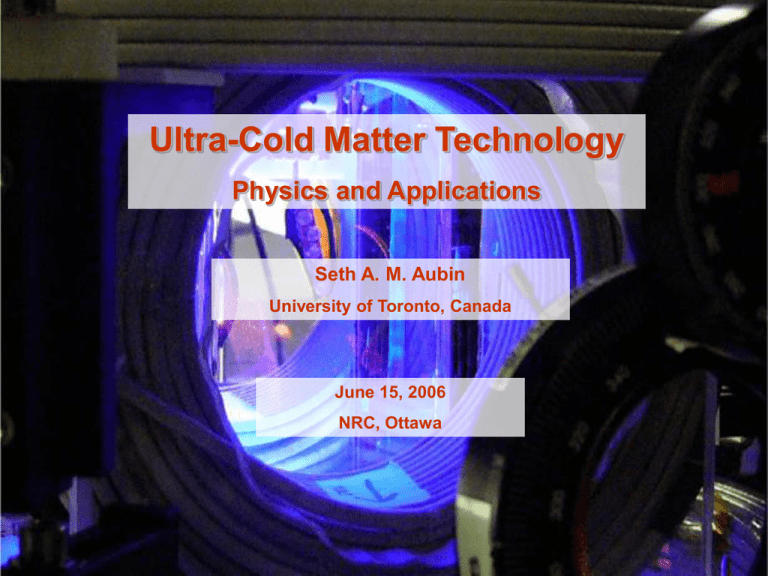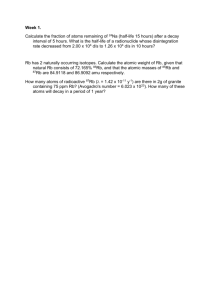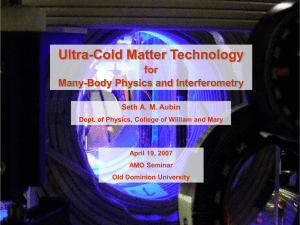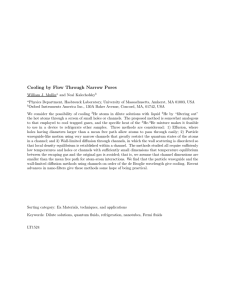Ultra-Cold Matter Technology Physics and Applications Seth A. M. Aubin
advertisement

Ultra-Cold Matter Technology
Physics and Applications
Seth A. M. Aubin
University of Toronto, Canada
June 15, 2006
NRC, Ottawa
Outline
Intro to Ultra-cold Matter
What is it ?
How do you make it ?
Bose-Einstein Condensates
Degenerate Fermi Gases
Physics
Past: 40K-87Rb cross-section.
Path A
Present: Matter-wave interferometry.
Path A
Future: Constructing larger quantum systems.
What’s Ultra-Cold Matter ?
mK
Very Cold
μK
Typically nanoKelvin – microKelvin
nK
Atoms/particles have velocity ~ mm/s – cm/s
Very Dense … in Phase Space
p
p
x
Different temperatures
Same phase space density
p
x
x
Higher
phase space density
Ultra-cold Quantum Mechanics
Quantum mechanics requires
p
Dx Dp /2
Dp
fundamental unit of phase space volume
x
Dx Dp /2
Dx
Quantum physics is important when
PSD ~ 1
Equivalent:
deBroglie wavelength ~ inter-particle separation
ndeBroglie ~ 1
Boltzmann
Quantum régime
régime
Quantum Statistics
Bosons
Fermions
symmetric multi-particle
wavefunction.
anti-symmetric multi-particle
wavefunction.
Integer spin: photons, 87Rb.
½-integer spin: electrons,
protons, neutrons, 40K.
probability of occupying a
state |i> with energy Ei.
P( Ei )
probability of occupying a
state |i> with energy Ei.
1
e
( Ei ) / kT
P( Ei )
1
NBEC
1
Ni
Ni
Ei
EF
1
e ( Ei ) / kT 1
Ei
How do you make ULTRA-COLD matter?
Two step process:
1. Laser cooling
Doppler cooling
Magneto-Optical Trap (MOT)
2. Evaporative cooling
Magnetic traps
Evaporation
Doppler Cooling
Lab frame
excited
v
ground
Atom’s frame
'
'
Lab frame, after absorption
v-vrecoil
2
87Rb: = -
m/s
Vrecoil
=
6
mm/s
Absorb a photon atom gets k momentum kick.
I = Isat
Repeat process at 107 kicks/s large deceleration.
Emitted photons are radiated symmetrically
Vdoppler ~10docm/s
not affect motion on average
m/s
Magneto-Optical Trap (MOT)
Problem:
Doppler cooling reduces momentum spread of atoms only.
Similar to a damping or friction force.
Does not reduce spatial spread.
Does not confine the atoms.
Solution:
Spatially tune the laser-atom detuning with the Zeeman shift from a
spatially varying magnetic field.
B,
z
~10 G/cm
~14 MHz/cm
Magneto-Optical Trap (MOT)
Magneto-Optical Trap (MOT)
10-13
10-6
1
thermal
atoms
Laser
cooling
quantum
behavior
~ 100 K
???
PSD
Magnetic Traps
Interaction between external magnetic field
and atomic magnetic moment:
U B
B
For an atom in the hyperfine state F, mF
cos mF / F
Energy = minimum
U g F mF B B
|B| = minimum
Micro-magnetic Traps
Advantages of “atom” chips:
Very tight confinement.
Fast evaporation time.
photo-lithographic production.
Integration of complex trapping
potentials.
Integration of RF, microwave and
optical elements.
Single vacuum chamber apparatus.
Iz
Evaporative Cooling
Remove most energetic
(hottest) atoms
Wait for atoms to
rethermalize among
themselves
Wait time is given by the elastic collision rate kelastic = n v
Macro-trap: low initial density, evaporation time ~ 10-30 s.
Micro-trap: high initial density, evaporation time ~ 1-2 s.
Evaporative Cooling
Remove most energetic
(hottest) atoms
P(v)
Wait for atoms to
rethermalize among
themselves
Wait time is given by the elastic collision rate kelastic = n v
Macro-trap: low initial density, evaporation time ~ 10-30 s.
Micro-trap: high initial density, evaporation time ~ 1-2 s.
v
RF Evaporation
In a harmonic trap:
B
RF
ERF
B
RF frequency determines energy at which
spin flip occurs.
Sweep RF between 1 MHz and 30 MHz.
Chip wire serves as RF B-field source.
Outline
Intro to Ultra-cold Matter
What is it ?
How do you make it ?
Bose-Einstein Condensates
Degenerate Fermi Gases
Physics
Past: 40K-87Rb cross-section.
Path A
Present: Matter-wave interferometry.
Path A
Future: Constructing larger quantum systems.
Bose-Einstein Condensation of 87Rb
10-13
thermal
atoms
10-6
MOT
magnetic
trapping
105
1
evap.
cooling
PSD
BEC
Evaporation Efficiency
d ln(PSD)
3.95 0.1
d ln(N)
87Rb
BEC
RF@1.740 MHz:
RF@1.725 MHz:
RF@1.660 MHz:
N = 7.3x105, T>Tc
N = 6.4x105, T~Tc
N=1.4x105, T<Tc
87Rb
BEC
RF@1.740 MHz:
RF@1.725 MHz:
RF@1.660 MHz:
N = 7.3x105, T>Tc
N = 6.4x105, T~Tc
N=1.4x105, T<Tc
Surprise! Reach Tc with
only a 30x loss in number.
(trap loaded with 2x107 atoms)
Experimental cycle = 5 - 15 seconds
Fermions: Sympathetic Cooling
Problem:
Cold identical fermions do not interact due
to Pauli Exclusion Principle.
No rethermalization.
No evaporative cooling.
Solution: add non-identical particles
Pauli exclusion principle
does not apply.
We cool our fermionic 40K atoms
sympathetically with an 87Rb BEC.
“Iceberg”
BEC
Fermi
Sea
Sympathetic Cooling
104
102
100
105
106
107
Cooling Efficiency
2
10
4
10
106
108
D ln(PSD)
8
D ln(N)
Below TF
0.9 TF
0.35 TF
For Boltzmann statistics and a harmonic trap,
For ultra-cold fermions, even at T=0,
1
2
1
2
mv2 12 kT v T
mv EF
2
EF
vF 2
m
Pauli Pressure
Fermi
Boltzmann
Gaussian Fit
First time on a chip !
S. Aubin et al.
Nature Physics 2, 384 (2006).
Outline
Intro to Ultra-cold Matter
What is it ?
How do you make it ?
Bose-Einstein Condensates
Degenerate Fermi Gases
Physics
Past: 40K-87Rb cross-section.
Path A
Present: Matter-wave interferometry.
Path A
Future: Constructing larger quantum systems.
What’s Special about
Ultra-cold Atoms ?
Extreme Control:
Perfect knowledge (T=0).
Precision external and internal control with magnetic, electric, and
electromagnetic fields.
Interactions:
Tunable interactions between atoms with a Feshbach resonance.
Slow dynamics for imaging.
Narrow internal energy levels:
Energy resolution of internal levels at the 1 part per 109 – 1014.
100+ years of spectroscopy.
Frequency measurements at 103-1014 Hz.
Ab initio calculable internal structure.
Past:
Surprises with Rb-K
cold collisions
Naïve Scattering Theory
Collision Rates
Rb-Rb
Rb-K
RbRb nRb RbRb vRbRb
RbK nRb RbK vRbK
2
8aRbRb
2
4a RbK
aRbRb 5.238 nm
aRbK 10.8 nm
RbK
2 .7
RbRb
Sympathetic cooling
should work really well !!!
Sympathetic cooling 1st try:
“Should just work !” -- Anonymous
Add 40K to 87Rb BEC No sympathetic cooling observed !
Experiment:
Sympathetic cooling only works
for slow evaporation
10
Evaporation 3 times slower
than for BEC
4
Phase Space Density
102
100
105
106
10-2
10-4
10-6
10-8
Atom Number
107
Cross-Section Measurement
TK40 (K)
Thermalization of 40K with 87Rb
What’s happening?
Rb-K Effective range theory
Rb-K Naïve theory
Rb-Rb cross-section
Present:
Atom Interferometry
Atom Interferometry
IDEA: replace photon waves with atom waves.
atom photon
Example: 87Rb atom @ v=1 m/s atom 5 nm.
green photon photon 500 nm.
2 orders of magnitude increase in resolution
at v=1 m/s !!!
Mach-Zender atom Interferometer:
Measure a phase difference
(D) between paths A and B.
Path A
D1
Path B
D2
DAB can be caused by a difference in length, force, energy, etc …
Bosons and Fermions … again
1st Idea: use a Bose-Einstein condensate
Photons (bosons) 87Rb (bosons)
Laser has all photons in same “spatial mode”/state.
BEC has all atoms in the same trap ground state.
Identical bosonic atoms interact through collisions.
PROBLEM
Good for evaporative cooling.
Bad for phase stability: interaction potential
energy depends on density -- DAB is unstable.
Better Idea: Use a gas of degenerate fermions
Ultra-cold identical fermions don’t interact.
DAB is independent of density !!!
Small/minor reduction in energy resolution
since DE ~ EF .
EF
RF beamsplitter
How do you beamsplit ultra-cold atoms ?
Energy
h
x
RF beamsplitter
How do you beamsplit ultra-cold atoms ?
Energy
h
x
RF beamsplitter
How do you beamsplit ultra-cold atoms ?
Energy
h
x
RF beamsplitter
How do you beamsplit ultra-cold atoms ?
Energy
Position of well is
determined by
hrabi =
Atom-RF coupling
h
x
Implementation
figure from Schumm et al., Nature Physics 1, 57 (2005).
RF splitting of ultra-cold 87Rb
Scan the RF magnetic field from 1.6 MHz to a final value
BRF ~ 1 Gauss
RF splitting of ultra-cold 87Rb
Scan the RF magnetic field from 1.6 MHz to a final value
BRF ~ 1 Gauss
RF splitting of ultra-cold 87Rb
Scan the RF magnetic field from 1.6 MHz to a final value
BRF ~ 1 Gauss
RF splitting of ultra-cold 87Rb
Scan the RF magnetic field from 1.6 MHz to a final value
BRF ~ 1 Gauss
RF splitting of ultra-cold 87Rb
Scan the RF magnetic field from 1.6 MHz to a final value
BRF ~ 1 Gauss
RF splitting of ultra-cold 87Rb
Scan the RF magnetic field from 1.6 MHz to a final value
BRF ~ 1 Gauss
RF splitting of ultra-cold 87Rb
Scan the RF magnetic field from 1.6 MHz to a final value
BRF ~ 1 Gauss
RF splitting of ultra-cold 87Rb
Scan the RF magnetic field from 1.6 MHz to a final value
BRF ~ 1 Gauss
Interferometry
Procedure:
Make ultra-cold atoms
Apply RF split
Turn off the trap
Probe atoms after a fixed time Time of Flight
Fringe spacing = (h TOF)/(mass splitting)
Bosonic 87Rb
figures courtesy
of T. Schumm
Future:
Condensed Matter Simulations
Condensed Matter Simulations
IDEA: use ultra-cold atoms to simulate electrons in a crystal.
useful if condensed matter experiment is difficult or theory is
intractable.
Advantages:
Atoms are more easily
controlled and probed than
electrons.
An optical lattice can
simulate a defect-free crystal
lattice.
All crystal and interaction
parameters are easily tuned.
The Hubbard Model
Model of particles moving on a lattice.
Simulates electrons moving in a crystal.
H t
a
{i , j },
i ,
a j , ai , a j , U ai, ai , ai, ai ,
Hopping term, kinetic energy
i
Particle-particle interaction
Optical Lattice
Laser standing wave creates
an optical lattice potential for
atoms.
Hopping term, t
control with laser intensity
Use a Feshbach resonance to
control atom-atom interaction, U.
tune with a magnetic field.
Bose-Hubbard Model
IDEA: Put a BEC in a 3D optical lattice.
Look for Mott-Insulator transition by varying ratio
U/t.
Gas undergoes a quantum phase transition from a
superfluid to an insulating state at U/t ~ 36 (cubic lattice).
Excellent agreement with theory !!!
Fischer et al., Phys. Rev. B 40, 546 (1989).
U/t~0
U/t < 36 U/t ~ 36 U/t > 36
Greiner et al., Nature 415, 39-44 (2002).
Jaksch et al., Phys. Rev. Lett. 3108 (1998).
Fermi-Hubbard Model
IDEA: do the same thing with fermions !!!
Put a degenerate Fermi gas in an optical lattice.
See what happens.
Theory:
Very hard not yet solved analytically.
Numerical simulations are difficult due to Fermi Sign Problem.
Computation is “NP hard”.
d-wave
superconductor !
Possible model for
high-Tc materials
n=filling fraction
Hofstetter, Cirac, Zoller, Demler, Lukin
Phys. Rev. Lett. 89, 220407 (2002).
Figure from K. Madison, UBC.
Summary
EF
Degenerate Bose-Fermi mixture on a chip.
Measured the 40K-87Rb cross-section.
Fermion Interferometry on a chip soon.
Condensed-matter simulations.
Thywissen Group
S. Aubin
D. McKay
B. Cieslak
S. Myrskog
M. H. T. Extavour
A. Stummer
T. Schumm
Colors:
Staff/Faculty
Postdoc
Grad Student
Undergraduate
L. J. LeBlanc
J. H. Thywissen
Thank You





